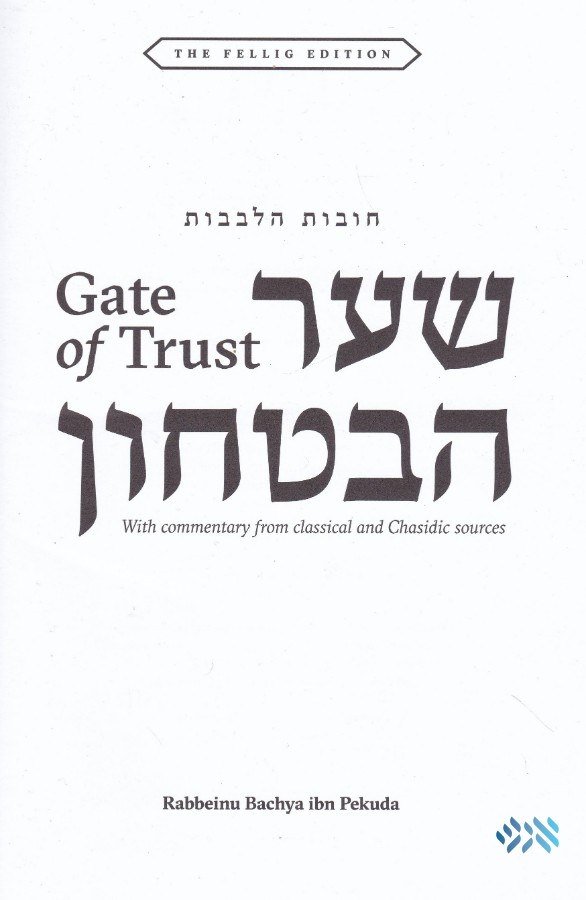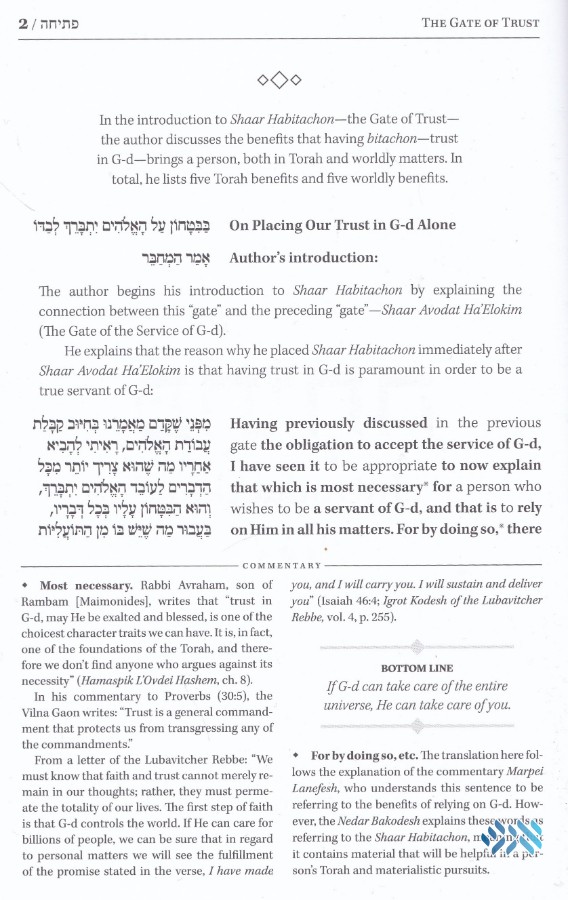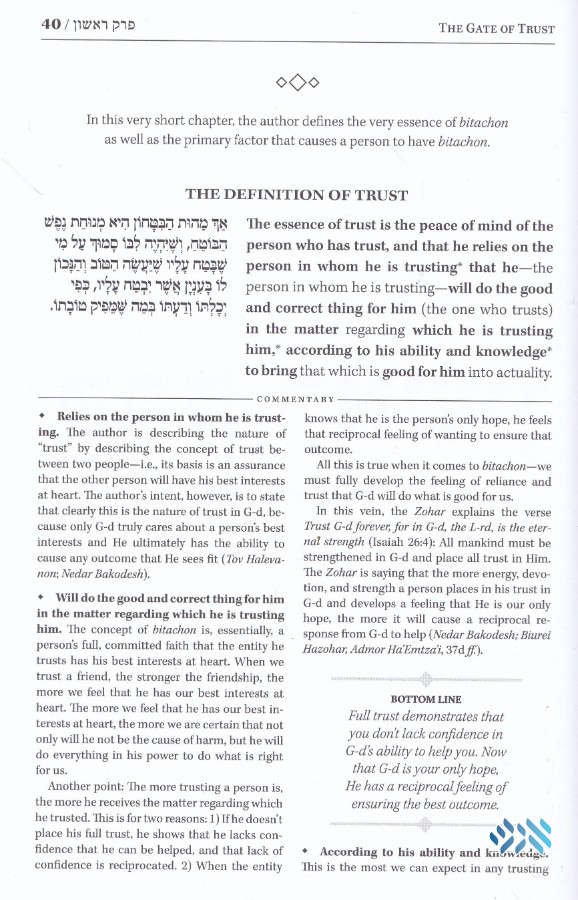A Look Inside the Book: Shaar Habitachon has been learned by Jews of all persuasions for decades to strengthen their trust in Hashem. A new edition, the result of a Chayenu-Kehos collaboration, is an excellent guide for the study of this fundamental work, as illuminated by the light of Chassidus.
By Shmuel Super
Shaar Habitachon: Gate of Trust
Rabeinu Bechaye ibn Pekuda, translated by Rabbi Yisroel Dovid Klein, with commentary by Rabbi Itzick Yarmush
Kehot Publication Society/Chayenu 5781
251 pages
Introduction
Chovos Halevavos, “Duties of the Heart” was written almost one thousand years ago by Rabeinu Bechaye (or Bachya) ibn Pekuda as a guide to avodas Hashem.
Chovos Halevavos as a whole is a classic work of Jewish thought, but its fourth “gate,” Shaar Habitachon, addressing trust in Hashem, has achieved special popularity. In letters, yechidus, and at dollars, the Rebbe often encouraged people who expressed worries and anxiety to study Shaar Habitachon to strengthen their trust in Hashem.
To make this vitally important classic more accessible to English speaking readers, Kehos has now published a new edition of Shaar Habitachon with a new translation and a commentary drawn from classical sources and the teachings of Chassidus. This book is published in conjunction with the weekly Chayenu publication, where its contents were originally serialized.
In this review, we will first describe the general format of the book and then take a closer look at its two primary elements: the translation and the commentary.
Format
The publisher’s foreword to our edition of Shaar Habitachon offers us no details about the editorial decisions regarding the book, leaving us to reconstruct this on our own.
Chovos Halevavos was originally written in Judeo-Arabic (Arabic in Hebrew letters). Shortly after its original publication it was translated into Hebrew by R. Yehudah ibn Tibbon, for the benefit of the Jewish public not conversant in Arabic.
This edition uses the Hebrew of the ibn Tibbon translation as its base and the accompanying English translation was created from this translation.
The format of the translation is paragraph by paragraph, with the English translation parallel to the Hebrew. The commentary appears at the bottom of the page, and is referenced with asterisks.
But this edition of Shaar Habitachon isn’t just a translation with a commentary. It functions like a teacher, carefully guiding the reader through the work step by step, ensuring the messages of the text are properly understood and assimilated.
This is accomplished by dividing the original chapters into sections with descriptive headers and the extensive use of explanatory paragraphs woven into the translation that summarize the previous piece of the text and introduce the following piece, thereby giving the reader a clear understanding of the flow of the work.
Each chapter concludes with a lengthier summary, and many helpful charts summarizing the points of Rabeinu Bechaye’s methodical arguments are provided within the commentary at the bottom of the page.
The general format of the book will be familiar to many readers as the one used by Sichos in English in recent years for their translations of maamarim and other foundational texts.
Translators have always struggled with the dilemma of prioritizing loyalty to the original text or favoring clear expression of its ideas. In recent times Artscroll have popularized a compromise path between the two—providing a literal translation in bold type and adding words in for clarity in regular type.
This format of translation is perfectly suited for students that wish to study from the original Hebrew but need to consult the translation for specific words or terms, as it allows for an almost literal word by word rendering, while minimizing the cost of such a rendering in terms of clarity.
The Kehos Shaar Habitachon employs this method of translation to the ibn Tibbon Hebrew. In the case of Chovos Halevavos the Hebrew is itself a translation and not the original, but the decision to publish the ibn Tibbon Hebrew alongside the English translation is nevertheless justifiable, as this Hebrew translation is the format in which most people have studied Shaar Habitachon for centuries. In addition, producing a new English translation directly from the Arabic is impractical, so the Hebrew translation has the value of being one step closer to the original.
However, considering that the Hebrew is not the original text, the strict use of this format when translating a translation, even placing simple conjunction words such as “and” and “to” in a separate font, seems unnecessary. A more liberal approach, prioritizing clarity over literal word by word translation, may have been more advisable.
The book is attractively designed and laid out, and the cover is appealing. It would also have been a good idea to provide a jacket to protect the beautiful cover, as this is a book that will hopefully be used for continual study.
Commentary
The novel feature of this book is the commentary, so it is this element we will explore first. The commentary includes explanation of the text of Shaar Habitachon culled from the mefarshim written on it such as Pas Lechem, Tov Halevanon, Ne’edar Bakodesh, and others.
But the true novelty of the commentary is the explanation based on Chabad Chassidus, and especially the Rebbe’s sichos and other works. Studying the explanations culled from Chassidus adds new depth to the study of Shaar Habitachon, illuminating the concepts with a new light.
For example, on p. 58 Rabeinu Bechaye writes that we must “believe and clearly recognize” that Hashem possesses the qualities that make him worthy of our trust. The commentary first quotes from Ne’edar Bakodesh that “belief” is based on the proofs Rabeinu Bechaye brings from pesukim, and “clear recognition” is based on the logical arguments he offers. The commentary then proceeds to draw from Likutei Sichos (vol. 27, p. 251ff.), explaining the importance Chassidus sees in both simple emunah and rational comprehension and why both are necessary.
On p. 103 Rabeinu Bechaye writes that when we work for a living our intention should be that we are doing this in order to fulfil Hashem’s command to do so. Based on multiple sources from Chassidus, the commentary elaborates that this attitude can be expressed on two distinct levels: (a) trusting that everything ultimately comes from Hashem, but still ascribing some importance to the medium through which we receives our sustenance, and (b) recognizing that the sole purpose of the medium is in order to fulfill Hashem’s will. Adopting and internalizing the second attitude, we are taught, resolves the apparent tension that may arise between devoting time to work and avodas Hashem, because it is now clear that Hashem alone is the source of success in work.
Most of these biurim were given on the topic of bitachon in general, not focusing on Shaar Habitachon specifically, so collecting them and adapting them so well to accompany the study of Shaar Habitachon is a major achievement.
An example of creative application of a teaching in Chassidus to Shaar Habitachon can be found on p. 102, where Rabeinu Bechaye advises us to pursue a means of livelihood that matches our natural abilities. The commentary cites from Hayom Yom (25 Nissan) where the same logic is applied to avodas Hashem—we all have our own personal mission in this world, for which we are given the necessary qualities to achieve, and it is this specific mission that we must focus on.
The unique combination of classical sources and Chassidus shows how Chassidus builds on the classic works of Jewish thought and illuminates them with a new light.
The commentary is clear and concise, and is a pleasure to read. Many of the notes in the commentary are followed by a brief summary of the takeaway message that can be gleaned from the piece. These appear in a larger font, under the title “Bottom Line.”
Translation
We will now turn to take a closer look at the translation. The style of the ibn Tibbon translation is medieval, and not always completely clear. As a result, recent years have seen a number of new translations of Chovos Halevavos from the Arabic. In addition to the best-known new Hebrew translation by R. Yosef Kapach, there is also a translation by R. Shmuel Kroizer (under the pen name of Yerushalmi), as well as a new academic translation by Professor Binyamin Abrahamov.
In English, there is a translation directly from the Arabic by Professor Menahem Mansoor, and two translations from the ibn Tibbon Hebrew: the Feldheim edition translated by R. Daniel Haberman, and the recently published Artscroll translation of Shaar Habitachon only.
When Shaar Habitachon was serialized in Chayenu, the Haberman translation was used, but for this book a new translation was done by R. Yisroel Dovid Klein.
A comparison with the aforementioned English translations shows the Kehos edition to be generally superior. The introductions, transitionary paragraphs, summaries, and charts combine to make this work easy to read and a pleasure to study.
However, there is room for improvement with regards to the accuracy of the translation. This issue appears to be the result of a hasty rush to produce the new translation, which came at the expense of a rigorous editorial process. The mistakes here are not major and do not impact the meaning of any of the important points of the book, but careful readers may be bothered by them and occasionally they make the flow harder to follow.
Due to the ambiguity of the ibn Tibbon translation, it is important to consult other translations to clarify the precise meaning of the original, even if the ibn Tibbon is being used as the basis for the English translation. The Artscroll and Feldheim translations note which other translations from the Arabic they consulted, and the Artscroll translation highlights in footnotes when the translations differ significantly.
The publisher’s foreword to the Kehos edition gives us no information about the methodology of the translation. A careful comparison with all of the aforementioned editions (with the exception of Abrahamov) indicates that our translation didn’t make use of them in any significant and systematic way. The other translations aren’t mentioned at all in the commentary section, and even on the one occasion (p. 161) where a sentence missing from the ibn Tibbon Hebrew was added to the English translation in non-bold parentheses, no explanation is given for its addition.
Many of the inaccuracies in the translation could have been avoided had the time been made to consult other translations from the original Arabic.
For example, יבטח בו . . . בכל מה שיטריחהו מענייניו should be translated as “trust him . . . with all matters he tasks him with,” not “trust him . . . regarding all pressing matters” (p. 46). On p. 65, Rabeinu Bechaye is illustrating Hashem’s kindness to us by pointing out that He doesn’t need us for anything, not just that He doesn’t need to do the specific act of kindness. The translation on p. 247 is also inaccurate and doesn’t fit the context.
While it may have been possible to make these mistakes based on the somewhat ambiguous wording of ibn Tibbon, they would have been avoided had the Kapach translation—or any of the others—been consulted to clarify the author’s intent.
At times it even appears as if the editors have momentarily forgotten that the ibn Tibbon Hebrew is only a translation and not the source. This can be seen when the commentary occasionally quotes alternative interpretations of the ibn Tibbon from the mefarshim on Chovos Halevavos that can be ruled out by consulting the other translations.
For example, on page 99, the word ספרות is vowelized and translated correctly as “writing.” But the commentary also quotes an alternative rendering from the Pas Lechem—“haircutting.” But consulting the original Judeo-Arabic (published by R. Kapach alongside his Hebrew translation) reveals that the Arabic word Rabeinu Bechaye used is אלכתאבה, which can only mean writing, as Google translate can confirm and as all other translations render it.
Writing in Eastern Europe over 200 years ago, Pas Lechem and the other mefarshim couldn’t have known this, but there is no reason to perpetuate such unfortunate mistakes now. The same applies to Pas Lechem’s variant reading of ibn Tibbon cited on p. 231.
Similarly, on p. 101, the Hebrew איל is vowelized as ayil and translated accordingly as “ram.” But a look at the Arabic original can confirm that this should in fact be ayol, a deer. According to the ibn Tibbon Hebrew, the tree Moshe Rabeinu used to sweeten the waters of Marah was the hardufni, whichour translation simply (and mistakenly) transliterates as “redofoni” (p. 128). Based on the original Arabic (and with some help from Google), this tree can be identified as the oleander. The oleander is a poisonous shrub, not just of bitter taste, so this identification actually better expresses the author’s point that Hashem can use even a naturally harmful substance as a remedy.
Occasionally, misunderstandings of the text make Rabeinu Bechaye’s line of thought difficult to follow. For example, the translator’s addition of the words “all the more so” on p. 64, is a mistake in peshat that renders the argument incoherent. And on p. 123 when Rabeinu Bechaye transitions from discussing life and death to the pursuit of material needs, he is in fact going back to the point established earlier on p. 113, that we need to rely completely on Hashem in this regard as well, not continuing his tangent about distancing oneself from danger, as our translation confusingly renders it. But such instances where inaccuracies affect the actual substance of the argument are rare.
Regrettably, the book is also littered with typos, missing words, wrong words, etc. Most are minor and merely annoying, but in rare instances this impedes comprehension of the text, as is the case on p. 50 where some words are missing from the translation, rendering it incoherent. This issue appears to be present primarily in the translation rather than the commentary, suggesting that the lack of proofreading can also be attributed to a rushed job on the translation and a lax editorial process.
Conclusion
The Kehos edition of Shaar Habitachon is an excellent guide for the study of this fundamental work. Readers will gain an understanding of what bitachon in Hashem is, how to cultivate it, and how to live by it—all illuminated by the light of Chassidus. The shortcomings identified in the translation and proofreading shouldn’t impede this in any significant way, and it is hoped that they will be resolved in a future edition.
Shaar HaBitachon – Gate of Trust can be purchased here.






BS”D
Here is a link to my favorite classes on Shaar Habitachoin!
https://www.gateoftrust.org/ another by product of Chayenu.
Wow! What an excellent review, so detailed, I love how he brings examples to show his points clearly, very helpful. I would have appreciated more comparison of ArtScroll version to this version.
Please keep doing these reviews, I really look forward to them!